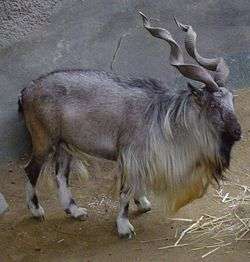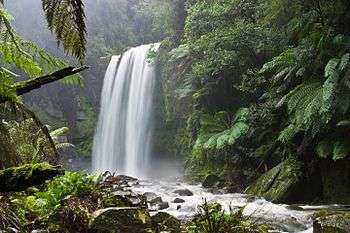Conservation in Pakistan

Conservation in Pakistan is the act of preserving, guarding, or protecting, biodiversity, environment, and natural resources of Pakistan.
Protected areas
The protected areas serve the purpose of conserving the forests and wildlife of Pakistan. National Conservation Strategy of 1993 was a major landmark of start of conservation of natural resources and wildlife in Pakistan. Resource-managed man-made forests like Changa Manga, Kamalia plantation and Chichawatni plantation have also been planted to serve purpose and conserve forests. Through conservation, a large region of Thal desert has been afforested.

- Natural protected forests
- Birir Valley Coniferous Forest[1] in Chitral District (also called 'Deodar Chilghoza Oak Forest')
- Jhangar Scrub Forest[2][3] in Chakwal District
- Sulaiman Coniferous Forest[4] in Khyber Pukhtunkhwa (also called 'Sulaiman Chilgoza Pine Forest')
- Ziarat Juniper Forest[5] in Ziarat District
- Artificial resource managed forests
- Changa Manga Forest in Lahore District
- Chichawatni Plantation in Sahiwal District
- Khipro Reserve Forest[6] in Sanghar District
Endangered species

Cheer pheasant, which became extinct in Pakistan, was planned to be reintroduced in the region. The World Pheasants Association sent 90 eggs of the species to the Dhodial Pheasantry. Among the eggs which hatched, the mortality was high and remained high till 1995. This situation got better in 1996. In 1997, a parent flock of 40 pairs was raised and eventually reintroduction of the cheer pheasant in Hazara District was carried out. As of 2007, there are around 60 pairs of cheer pheasant in the Dhodial Pheasantry.
Pakistan Crane Center is a conservation center for the captive breeding of common crane and demoiselle crane. It is located west of Kurram River in Lakki Marwat, Khyber Pakhtunkhwa, Pakistan, 250 kilometres (155 mi) south of Peshawar. The center is equipped with a total of 15 circular aviaries as well as an education block for visitors.[7] The center is operated by the Bannu Wildlife Division, Bannu and Pakistan Wetlands Programme of Ministry of Environment (Pakistan). The programme is funded by WWF - Pakistan, GEF, UNDP and Darwin Initiative.[8]
Notable conservation organisations
Pakistan Environmental Protection Agency (PEPA)
See also
- Environment of Pakistan
- Forestry in Pakistan
- List of endangered species in Pakistan
- Protected areas of Pakistan
- Dhodial Pheasantry
References
- ↑ "Birir Valley Coniferous Forests". wwfpak.org. WWF Pakistan. Retrieved 14 August 2010.
- ↑ "Remains of Jhangar scrub forest". wildlifeofpakistan.com. Retrieved 14 August 2010.
- ↑ "Jhangar Scrub Forest". wwfpak.org. WWF Pakistan. Retrieved 14 August 2010.
- ↑ "Sulaiman Chilgoza Pine Forest". wwfpak.org. WWF Pakistan. Retrieved 14 August 2010.
- ↑ "Zarghoon Juniper Forest". wwfpak.org. WWF Pakistan. Retrieved 14 August 2010.
- ↑ "Khipro Reserve Forest". pakistani.tumblr.com. Mahadev Dheerani. Retrieved 14 August 2010.
- ↑ "Tavels with George: International Travel, Fall 2006". savingcranes.org. Lakki Marwat, Pakistan: International Crane Foundation. November 3–5, 2006. Retrieved July 21, 2011.
- ↑ Zafar Ali. "Captive Cranes of North West Frontier Province, Pakistan" (PDF). pakistanwetlands.org. Pakistan Wetlands Programme, Ministry of Environment (Pakistan). Archived from the original (PDF) on March 25, 2012. Retrieved July 21, 2011.
